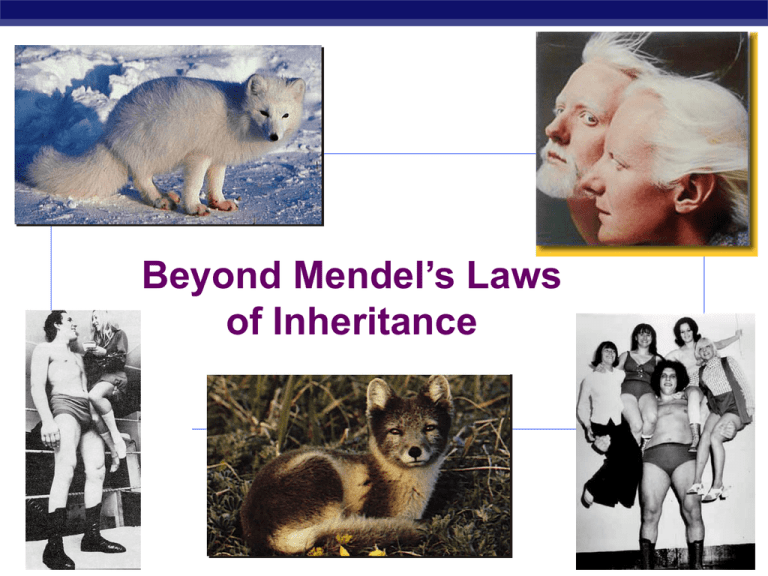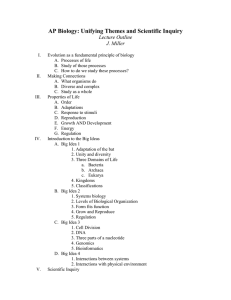Chapter 14.
advertisement

Beyond Mendel’s Laws of Inheritance AP Biology 2006-2007 Extending Mendelian genetics Mendel worked with a simple system peas are genetically simple most traits are controlled by a single gene each gene has only 2 alleles, 1 of which is completely dominant to the other The relationship between genotype & phenotype is rarely that simple AP Biology Incomplete dominance Heterozygote shows an intermediate, blended phenotype example: RR = red flowers rr = white flowers Rr = pink flowers make 50% less color AP Biology RR Rr rr Incomplete dominance P X true-breeding red flowers true-breeding white flowers 100% pink flowers F1 100% generation (hybrids) self-pollinate 25% red F2 generation AP Biology 50% pink 25% white It’s like flipping 2 pennies! 1:2:1 Incomplete dominance CRCW x C RCW % genotype female / eggs male / sperm CR CW CR CW CRCR CRCW CRCR CRCW 25% 25% 50% 50% CRCW CRC W C WC W C WC W 25% 25% 1:2:1 AP Biology % phenotype 1:2:1 Co-dominance 2 alleles affect the phenotype equally & separately not blended phenotype example: ABO blood groups 3 alleles IA, IB, i IA & IB alleles are co-dominant to each other both antigens are produced both IA & IB are dominant to i allele AP Biology produces glycoprotein antigen markers on the surface of red blood cells Genetics of Blood type phenogenotype type A B AB O AP Biology antigen on RBC antibodies in blood donation status IA IA or IA i type A antigens on surface of RBC anti-B antibodies __ IB IB or IB i type B antigens on surface of RBC anti-A antibodies __ IA IB both type A & type B antigens on surface of RBC no antibodies universal recipient ii no antigens on surface of RBC anti-A & anti-B antibodies universal donor Blood compatibility 1901 | 1930 Matching compatible blood groups critical for blood transfusions A person produces antibodies against antigens in foreign blood wrong blood type donor’s blood has A or B antigen that is foreign to recipient antibodies in recipient’s blood bind to foreign molecules cause donated blood cells to clump together can kill the recipient AP Biology Karl Landsteiner (1868-1943) Blood donation clotting clotting clotting clotting AP Biology clotting clotting clotting Pleiotropy Most genes are pleiotropic one gene affects more than one phenotypic character wide-ranging effects due to a single gene dwarfism (achondroplasia) gigantism (acromegaly) AP Biology Acromegaly: André the Giant AP Biology Inheritance pattern of Achondroplasia Aa x aa a a A Aa Aa A a aa aa a 50% dwarf:50% AP Biology normal or 1:1 Aa x Aa A a AA Aa Aa aa 67% dwarf:33% normal or 2:1 Epistasis One gene completely masks another gene coat color in mice = 2 separate genes C,c: B_C_ bbC_ _ _cc AP Biology pigment (C) or no pigment (c) B,b: more pigment (black=B) or less (brown=b) cc = albino, no matter B allele 9:3:3:1 becomes 9:3:4 How would you know that difference wasn’t random chance? Chi-square test! Epistasis in Labrador retrievers 2 genes: (E,e) & (B,b) pigment (E) or no pigment (e) pigment concentration: black (B) to brown (b) eebb AP Biology eeB– E–bb E–B– Epistasis in grain color X White (AAbb) White (aaBB) F1 generation A = enzyme 1 + B = enzyme 2 purple color (anthocyanin) AP Biology All purple (AaBb) Eggs AB Ab aB ab AB AABB AABb AaBBAaBb Ab AABbAAbb AaBb Aabb Sperm 9:3:3:1 aB AaBB AaBb aaBB aaBb 9:7 ab AaBb Aabb aaBb aabb F2 generation 9/16 purple 7/16 white Polygenic inheritance Some phenotypes determined by additive effects of 2 or more genes on a single character phenotypes on a continuum human traits skin color height weight eye color intelligence behaviors AP Biology Skin color: Albinism Johnny & Edgar Winter However albinism can be inherited as a single gene trait albino Africans melanin = universal brown color enzyme tyrosine AP Biology melanin albinism OCA1 albino AP Biology Bianca Knowlton Sex linked traits 1910 | 1933 Genes are on sex chromosomes as opposed to autosomal chromosomes first discovered by T.H. Morgan at Columbia U. Drosophila breeding good genetic subject prolific 2 week generations 4 pairs of chromosomes XX=female, XY=male AP Biology Classes of chromosomes autosomal chromosomes sex chromosomes AP Biology Discovery of sex linkage P F1 true-breeding red-eye female X true-breeding white-eye male 100% red eye offspring Huh! Sex matters?! generation (hybrids) F2 generation AP Biology 100% red-eye female 50% red-eye male 50% white eye male What’s up with Morgan’s flies? x RR r R Rr x rr Rr r Rr Rr R R r RR Rr Rr rr Doesn’t work that way! R AP Biology Rr Rr 100% red eyes r 3 red : 1 white Genetics of Sex In humans & other mammals, there are 2 sex chromosomes: X & Y 2 X chromosomes develop as a female: XX gene redundancy, like autosomal chromosomes an X & Y chromosome X Y X XX XY X XX XY develop as a male: XY no redundancy AP Biology 50% female : 50% male What’s up with Morgan’s flies? x XR XR Xr XR XR AP Biology XR Xr XR Xr x XrY Y XRY XRY 100% red eyes XR BINGO! Xr XR Xr XRY XR Y XR XR XRY XR Xr X rY 100% red females 50% red males; 50% white males Genes on sex chromosomes Y chromosome few genes other than SRY sex-determining region master regulator for maleness turns on genes for production of male hormones many effects = pleiotropy! X chromosome AP Biology other genes/traits beyond sex determination mutations: hemophilia Duchenne muscular dystrophy Human X chromosome Sex-linked Duchenne muscular dystrophy Becker muscular dystrophy usually means “X-linked” more than 60 diseases traced to genes on X chromosome Chronic granulomatous disease Retinitis pigmentosa-3 Norrie disease Retinitis pigmentosa-2 Hypophosphatemia Aicardi syndrome Hypomagnesemia, X-linked Ocular albinism Retinoschisis Adrenal hypoplasia Glycerol kinase deficiency Ornithine transcarbamylase deficiency Incontinentia pigmenti Wiskott-Aldrich syndrome Menkes syndrome Androgen insensitivity Sideroblastic anemia Aarskog-Scott syndrome PGK deficiency hemolytic anemia Anhidrotic ectodermal dysplasia Agammaglobulinemia Kennedy disease Pelizaeus-Merzbacher disease Alport syndrome Fabry disease Immunodeficiency, X-linked, with hyper IgM Lymphoproliferative syndrome Albinism-deafness syndrome Fragile-X syndrome AP Biology Ichthyosis, X-linked Placental steroid sulfatase deficiency Kallmann syndrome Chondrodysplasia punctata, X-linked recessive Charcot-Marie-Tooth neuropathy Choroideremia Cleft palate, X-linked Spastic paraplegia, X-linked, uncomplicated Deafness with stapes fixation PRPS-related gout Lowe syndrome Lesch-Nyhan syndrome HPRT-related gout Hunter syndrome Hemophilia B Hemophilia A G6PD deficiency: favism Drug-sensitive anemia Chronic hemolytic anemia Manic-depressive illness, X-linked Colorblindness, (several forms) Dyskeratosis congenita TKCR syndrome Adrenoleukodystrophy Adrenomyeloneuropathy Emery-Dreifuss muscular dystrophy Diabetes insipidus, renal Myotubular myopathy, X-linked Map of Human Y chromosome? < 30 genes on Y chromosome Sex-determining Region Y (SRY) Channel Flipping (FLP) Catching & Throwing (BLZ-1) Self confidence (BLZ-2) Devotion to sports (BUD-E) Addiction to death & destruction movies (SAW-2) note: not linked to ability gene Air guitar (RIF) Scratching (ITCH-E) Spitting (P2E) Inability to express affection over phone (ME-2) AP Biology linked Selective hearing loss (HUH) Total lack of recall for dates (OOPS) Sex-linked traits summary X-linked follow the X chromosomes males get their X from their mother trait is never passed from father to son Y-linked very few genes / traits trait is only passed from father to son females cannot inherit trait AP Biology AP Biology AP Biology sex-linked recessive Hemophilia H Xh x X HY HH XHh XH female / eggs male / sperm XH XH Y XH XH XH Y XH Xh Xh XH Xh AP Biology XH Xh XhY carrier disease XHY Y X-inactivation Female mammals inherit 2 X chromosomes one X becomes inactivated during embryonic development condenses into compact object = Barr body which X becomes Barr body is random patchwork trait = “mosaic” XH XH X h Xh AP Biology X-inactivation & tortoise shell cat 2 different cell lines in cat AP Biology Male pattern baldness Sex influenced trait autosomal trait influenced by sex hormones age effect as well = onset after 30 years old dominant in males & recessive in females B_ = bald in males; bb = bald in females AP Biology Nature vs. nurture Phenotype is controlled by both environment & genes Human skin color is influenced by both genetics & environmental conditions Coat color in arctic fox influenced by heat sensitive alleles Color of Hydrangea flowers APinfluenced Biology is by soil pH Any Questions? AP Biology 2006-2007 Mechanisms of Inheritance How do we go from DNA to trait? ? AP Biology vs. 2006-2007 Mechanisms of inheritance What causes the differences in alleles of a trait? yellow vs. green color smooth vs. wrinkled seeds dark vs. light skin sickle cell anemia vs. no disease What causes dominance vs. recessive? AP Biology Molecular mechanisms of inheritance Molecular basis of inheritance genes code for polypeptides polypeptides are processed into proteins proteins function as… enzymes structural proteins regulators hormones gene activators gene inhibitors DNA AP Biology RNA protein trait How does dominance work: enzyme = allele coding for functional enzyme protein heterozygous = allele coding for non-functional enzyme protein = 50% functional enzyme sufficient enzyme present normal trait is expressed normal trait is DOMINANT Aa carrier homozygous recessive = 100% non-functional enzyme mutant trait is expressed aa homozygous dominant = 100% functional enzyme normal trait is expressed AA AP Biology example: enzyme has incorrect structure at active site How does dominance work: structure = allele coding for functional structural protein heterozygous = allele coding for non-functional structural protein = 50% functional structure 50% proteins malformed mutant trait is expressed mutant trait is DOMINANT Aa homozygous dominant = 100% non-functional structure mutant trait is expressed AA homozygous recessive = 100% functional structure normal trait is expressed aa AP Biology channel protein, example: malformed receptor protein, “stuck “stuck open” on” Prevalence of dominance Because an allele is dominant does not mean… it is better, or it is more common AP Biology Polydactyly dominant allele Polydactyly individuals are born with extra fingers or toes the allele for >5 fingers/toes is DOMINANT & the allele for 5 digits is recessive recessive allele far more common than dominant only 1 individual out of 500 has more than 5 fingers/toes so 499 out of 500 people are AP Biology homozygous recessive (aa) Any Questions? AP Biology 2006-2007


